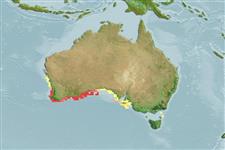>
Blenniiformes (Blennies) >
Clinidae (Clinids)
Etymology: Ophiclinops: Greek, ophis = serpent + Greek, klinein, kline = sloping and bed, due to the four apophyses of sphenoid bone + Greek, ops = appearance (Ref. 45335).
Environment: milieu / climate zone / depth range / distribution range
Écologie
marin récifal; profondeur 13 - 15 m (Ref. 33839). Temperate
Eastern Indian Ocean: southern Australia.
Taille / Poids / Âge
Maturity: Lm ? range ? - ? cm
Max length : 9.5 cm TL mâle / non sexé; (Ref. 33839)
Description synthétique
Clés d'identification | Morphologie | Morphométrie
Épines dorsales (Total) : 56 - 59; Rayons mous dorsaux (Total) : 1; Épines anales: 2; Rayons mous anaux: 43 - 45. Remarks: pectorals tiny, length less than eye diameter.
Found in areas with seagrass, reef and weed (Ref. 33839). Minimum depth from Ref. 58018.
Life cycle and mating behavior
Maturities | Reproduction | Spawnings | Egg(s) | Fecundities | Larves
Gomon, M.F., C.J.M. Glover and R.H. Kuiter (eds.), 1994. The fishes of Australia's south coast. State Print, Adelaide. 992 p. (Ref. 33839)
Statut dans la liste rouge de l'IUCN (Ref. 130435)
Menace pour l'homme
Harmless
Utilisations par l'homme
Outils
Articles particuliers
Télécharger en XML
Sources Internet
Estimates based on models
Preferred temperature (Ref.
123201): 17.4 - 18.4, mean 18 °C (based on 46 cells).
Phylogenetic diversity index (Ref.
82804): PD
50 = 0.6250 [Uniqueness, from 0.5 = low to 2.0 = high].
Bayesian length-weight: a=0.00513 (0.00223 - 0.01182), b=3.06 (2.86 - 3.26), in cm total length, based on LWR estimates for this (Sub)family-body shape (Ref.
93245).
Niveau trophique (Ref.
69278): 3.3 ±0.4 se; based on size and trophs of closest relatives
Résilience (Ref.
120179): Haut, temps minimum de doublement de population inférieur à 15 mois (Preliminary K or Fecundity.).
Fishing Vulnerability (Ref.
59153): Low vulnerability (10 of 100).
